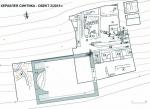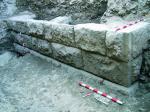Summary (English)
HERACLEA SINTICA (Lyudmil Vagalinski – lvagalin@techno-link.com) The explorations continued in Sondage 9, to the south of the Late Roman vaulted shops. A corner of a building was discovered, with walls 85 cm wide, built of ashlars with a core structure of roughly-cut stones bonded with clay. The building was burned. The debris contained Early Hellenistic finds, including coins – two minted by Philip of Macedon, and an amphora stamp of Akanthos of 330 – 300 BC. The building was constructed during the second half of the 4th century BC and was destroyed at the end of the century. Probably, it belonged to the Early Hellenistic agora. The finds from the excavations included Early Hellenistic bronze coins, sherds, fragments from building ceramics, lead slingshots, amphora stamps and terracotta loom weights. The archaeobotanical analysis of the timber burned during the fire at of the 4th century BC identified building elements from pine, poplar and oak, the presence of cherry trees, and two fragments from bread from common wheat, einkorn and millet. The bones from oxen and sheep/goats prevailed among the osteological material from the Early Hellenistic stratum. Bones from dogs, pigs, horses, donkeys, rabbits and deer also occurred and a bone from bear was found.
- Lyudmil Vagalinski - Archaeological Institute with Museum
Director
Team
Research Body
- Archaeological Institute with Museum






![Download [PDF]](/excavation/skins/fasti/images/results/download_sml.png)
